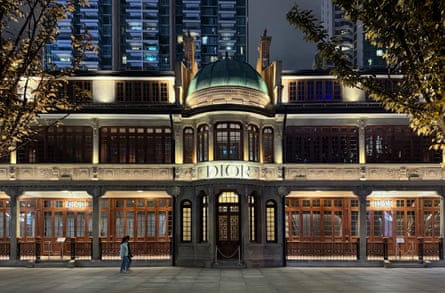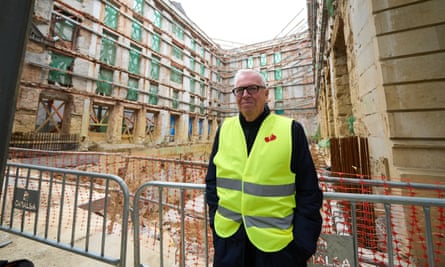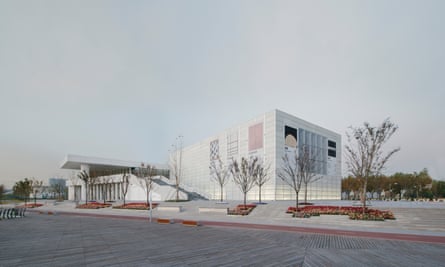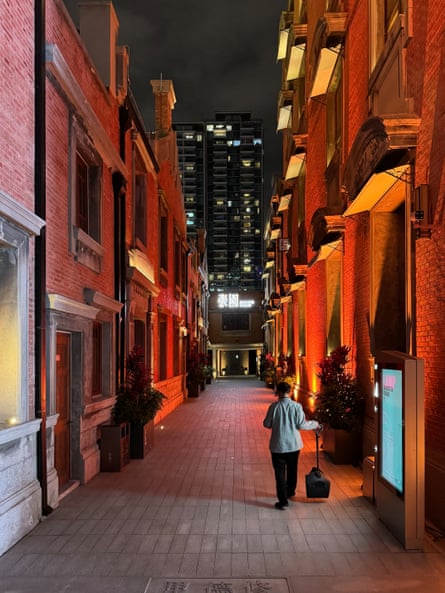A young woman wearing a short pleated skirt and a white bobble hat is posing for photos on a street corner in Shanghai, telling her friend to ensure that a red brick, colonial-era building features in the background. Nearby, a woman in stilettos and fur coat is being photographed in an arched doorway framed by classical mouldings, while another perches on a windowsill, coffee in hand next to a carved column. The alleyways behind are filled with similar scenes: people posing on steps, next to lampposts or in front of plain brick walls.
This surreal swarm of influencers is now a daily sight at Rockbund, a $1bn mixed-use development that includes the restoration of a dozen 1930s buildings, led by the British architect David Chipperfield. It seems an unlikely place to have become a social media sensation: a row of vaguely classical brick frontages now occupied by restaurants, boutiques and coffee shops, with office and apartment blocks rising behind. But a quick look on social media – Douyin (TikTok) and Xiaohongshu (Little Red Book, an Instagram equivalent) – explains the allure of this place for Shanghai’s gen Z.
“This is not New York,” says one woman’s post, showing her in one of the alleyways in head-to-toe Chanel, framed by red brick walls. “This is Shanghai! Come here to appreciate the respect for history shown in the protection of buildings #WhereToGoOnTheWeekend.” “A space that blends old and new,” coos another. “Like a back alley, a silent museum. With rich historic heritage and cultural charm, it’s hard not to love it.” Another declares it to be “a holy place for taking photos” with “a luxurious and elegant atmosphere”.

Many posts are hashtagged gaojigan, which means “high-class feeling”, an aspirational trait for China’s young. Here, this feeling is provided by a rare phenomenon in Shanghai: architectural heritage that has been neither demolished nor rebuilt in a Disneyfied style, but instead carefully restored, retaining the patina of age. Unlike most Communist party apparatchiks, who for years have been intent on bulldozing the city’s historic fabric, twentysomethings in China seem to appreciate the difference.
“The original plan was to tear most of it down,” says Chipperfield, sitting in his London home on Portland Place, incidentally located across from the Chinese embassy. “It was fairly second-division stuff compared to the grand stone buildings along the Bund – predominantly brick and not so well built.”
Laid out in the 1930s to house a range of colonial institutions from the China Baptist Publication Society to the Young Women’s Christian Association, Yuanmingyuan Road is a fascinating time capsule of European architectural styles, tentatively combined with traditional Chinese elements. Classical facades are offset with geometric plaster reliefs, brick pilasters are topped with lotus-shaped flourishes, while some surviving interiors feature intricate panelled screens. Only four of the buildings had protected status, but the architects convinced the authorities that 11 should remain – and keep their scars. As Libin Chen, the director of Chipperfield’s Shanghai office, puts it: “If you send an old man to hospital, you don’t want a young man to come out.”
The surgery has been a slow, arduous process. The project has been going on for 18 years, led by Hong Kong-listed investment company Sinolink and the US Rockefeller Group, along with state-owned Shanghai Bund Investment Group. The historic facades have been meticulously cleaned and repaired, and interior details, like terrazzo-floored lobbies, lovingly restored. But perhaps the most important elements are the bits between the buildings, where a network of backland alleyways was recently opened up into public spaces leading to a central square – providing popular posing spots for the influencer crowd.

Here, Chipperfield has transformed the former HQ of the Royal Asiatic Society into the Rockbund Art Museum. First opened in 2011, it now enjoys an entrance facing the square, with a new facade in the architect’s trademark austere modernist language – made with textured Shanghai plaster, historically used as a cheap alternative to stone, but now a rare craft. “Shanghainese only care about the surface,” jokes Chen. “The rich stone facades were only ever one metre deep, then it was always plaster around the sides.”
X Zhu-Nowell, the gallery’s artistic director, loves these upgrades. “The new entrance has changed everything,” they say. “Before, we had a very small door on the other side of the block, but now the social dynamic of the space has shifted and we’re attracting new audiences – partly driven by this unexpected social media phenomenon.”
One of the most popular selfie spots is the zebra crossing at the southern end, where young women queue up to be photographed crossing the road, Beatles-style, with the classical arches of a 19th-century office building in the background. Part of the attraction might be its new addition: a 60-metre tall brick tower sprouting from the historic carcass, stepping back as it rises. “The developer wanted additional floor area,” says Chen. “So we decided to concentrate it all at one end.” This is the first of its kind in Shanghai, a refreshing foil to the mirror-glass shafts elsewhere.

Still, not everyone is impressed. Over dinner, one local architect speaks his mind. “They call it a preservation project,” he says, crunching on a crab claw and spitting out shell. “I call it a demolition project.” What may not be immediately obvious is that half of the city block, facing the street behind, has been bulldozed and replaced with corpulent slabs of offices and flats, designed by the Shanghai office of Miami firm Arquitectonica. They have been built in a relatively sympathetic, stripped art deco style, clad in buff stone, but it feels like a missed opportunity to retain more of the historic urban grain – especially as the market for high-end apartments has collapsed. “There’s a faultline running down the middle of the block,” says Chipperfield. “These buildings were out of our control.”
The question of control hangs over the architect’s other work in Shanghai. In the last decade, his office has become the go-to international firm for high-profile, often government-connected projects. He completed the Shanghai branch of the Pompidou Centre, known as the West Bund Museum, in 2019, led the redevelopment of the historic Zhangyuan area, which opened last year, and has nearly finished the restoration and extension of the Shanghai Municipal Council building, a political symbol since its completion in 1922. But he doesn’t seem entirely comfortable with the results.

“I’m not so happy with the West Bund project,” says Chipperfield, explaining how his office was approached before the Pompidou came on board, to design a series of big, flexible, black box spaces, “without a museum director, without a programme, without anything”. He adds: “We did all the drawings to get planning permission, then nothing happened. One day I got a call from someone at the Pompidou, saying, ‘We’re so excited about the project; could we meet?’ I said, ‘What project?’ We discovered that they were already building it, before we had done any detailed design.”
Visiting today, it feels like a Chipperfield sketch filtered through a developer’s lens, a blunt cluster of containers, with little of the refined detail you might expect from the Pritzker prize winner. Still, it seems to be popular, and in the conspicuous-consumption capital of Shanghai, attracts enough people happy to shell out £20 for a ticket and enjoy £5 coffees in the waterfront cafe.
Elsewhere, the lack of control takes a different form. Zhangyuan is one of Shanghai’s most important historic lilong, or lane house, neighbourhoods – home to a rich variety of shikumen residences: a classic Shanghai style that combines western and Chinese elements. Built in the 1920s, it is a dense grid of narrow lanes, with two- and three-storey courtyard homes protected by high walls. In 2019, the local government decreed that residents would be moved out and the area turned into mixed-use development for “leisure, commerce, fashion and culture”. Chipperfield won the competition in 2020 and now, where families once lived – in admittedly overcrowded conditions – stands an open-air mall where Dior and Louis Vuitton flagship stores occupy the former homes in a ghoulish historicist cosplay.

Chipperfield is rueful. “From the beginning, we always say, ‘Isn’t there a way of decanting people and bringing them back? But even Libin will say, ‘People don’t want to come back. They’re offered something better further out, with modern kitchens etc. They want that.’ I have to trust his judgment. You’re trying to understand the cultural framework as well as the fiscal one.”
Is it worth pursuing work in China, if he can’t have control over the quality of construction, or influence the broader social programme in the way he would like? “Over the last 18 years, at regular intervals, I have said, ‘Why do I have an office in Shanghai?’ It’s a pointless exercise in some sense. But you have to take the risk. In the early 2000s we did a housing project in Hangzhou that I think is one of our best projects anywhere. A super client, very good quality finish. For each one of those, you get 20 rubbish things.”
Is he ever worried about having his name attached to these projects? “Of course. And this is part of the experiment. You can’t export all your values and your expectations on to a culture that’s not going to do it. So then the question is: why bother? Or are you adding something? Starting my office in late 1980s London, I really had to duck and dive. I had to get on a plane to Japan to get my first projects, so I suppose I surrendered to the idea that one might be more strategic and accept the risk. When you start a project, you never quite know how things will turn out.”

Outside his window, across the road, the red flag of the People’s Republic of China hangs in the street. It is a reminder of Chipperfield’s recent project to design a new home for the Chinese embassy in east London, which hit the buffers in 2022 when Tower Hamlets refused planning permission – in part due to criticism from its Muslim residents about the treatment of Uyghurs in Xinjiang. Did the architect have any sleepless nights about the country’s human rights record?
“It was a concern,” he says. “But my feeling is that we were working on a piece of diplomatic machinery, which is necessary in any situation. I didn’t feel like I was supporting a regime. I was supporting the idea of diplomacy.”
He says the ethical issues around such projects are hotly debated in his Berlin office, which allows staff to vote on which commissions they take on. The practice recently came together to hammer out a charter, but Chipperfield pulled it to bits. “It said we wouldn’t do prisons. But if I was approached by the Swiss government to do a prison, I presume they’d be coming to us because we might do an innovative prison. Then it said we wouldn’t work for anyone that had a criminal record. What about Nelson Mandela? Ultimately, you have to take each project and smell it out.”
Chipperfield is optimistic about China’s shifting attitudes to built heritage and its apparent drive for sustainability. The economic slowdown has also proved useful, making the retention and reuse of existing buildings a more attractive option for developers. He is currently working on another competition in Shanghai, where the reuse of a group of industrial buildings is a prerequisite.
“What China can do that no other country can,” he says, “is put blanket policies on top of society. So if they imposed criteria about reusing existing buildings, it would happen overnight.” Perhaps he could have the ambassador over for tea – and have a word in his ear.







